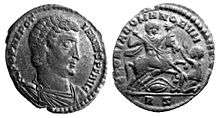350
This article is about the year 350. For the international organisation, see 350.org.
| Millennium: | 1st millennium |
|---|---|
| Centuries: | 3rd century · 4th century · 5th century |
| Decades: | 320s · 330s · 340s · 350s · 360s · 370s · 380s |
| Years: | 347 · 348 · 349 · 350 · 351 · 352 · 353 |
| 350 by topic | |
| Politics | |
| State leaders – Sovereign states | |
| Birth and death categories | |
| Births – Deaths | |
| Establishment and disestablishment categories | |
| Establishments – Disestablishments | |
| Gregorian calendar | 350 CCCL |
| Ab urbe condita | 1103 |
| Assyrian calendar | 5100 |
| Bengali calendar | −243 |
| Berber calendar | 1300 |
| Buddhist calendar | 894 |
| Burmese calendar | −288 |
| Byzantine calendar | 5858–5859 |
| Chinese calendar | 己酉年 (Earth Rooster) 3046 or 2986 — to — 庚戌年 (Metal Dog) 3047 or 2987 |
| Coptic calendar | 66–67 |
| Discordian calendar | 1516 |
| Ethiopian calendar | 342–343 |
| Hebrew calendar | 4110–4111 |
| Hindu calendars | |
| - Vikram Samvat | 406–407 |
| - Shaka Samvat | 271–272 |
| - Kali Yuga | 3450–3451 |
| Holocene calendar | 10350 |
| Iranian calendar | 272 BP – 271 BP |
| Islamic calendar | 280 BH – 279 BH |
| Javanese calendar | 232–233 |
| Julian calendar | 350 CCCL |
| Korean calendar | 2683 |
| Minguo calendar | 1562 before ROC 民前1562年 |
| Nanakshahi calendar | −1118 |
| Seleucid era | 661/662 AG |
| Thai solar calendar | 892–893 |
| Wikimedia Commons has media related to 350. |
Year 350 (CCCL) was a common year starting on Monday (link will display the full calendar) of the Julian calendar. At the time, it was known as the Year of the Consulship of Sergius and Nigrinianus (or, less frequently, year 1103 Ab urbe condita). The denomination 350 for this year has been used since the early medieval period, when the Anno Domini calendar era became the prevalent method in Europe for naming years.
Events
By place
Roman Empire
- January 18 – The Western Roman Emperor Constans I makes himself extremely unpopular; one of his generals, Magnus Magnentius, is proclaimed emperor at Augustodunum in the Diocese of Galliae, with the support of the army on the Rhine frontier.
- January – Constans I flees towards Spain, where he is subsequently assassinated at Castrum Helenae. Magnentius rules the Western Roman Empire and is far more tolerant towards Christians and Pagans alike.
- March 1 – Vetranio is asked by Constantina, sister of Constantius II, to proclaim himself Caesar. Constantius accepts the new emperor and sends him funds to raise an army.
- June 3 – Iulius Nepotianus, Roman usurper, proclaims himself "emperor" and enters Rome with a group of gladiators.
- June 30 – Nepotianus is defeated and killed by Marcellinus, a trusted general sent by Magnentius. His head is put on a spear and carried around the city.
- December 25 – Vetranio meets Constantius II at Naissus (Serbia) and joins forces with him. Vetranio is forced to abdicate his title, and Constantius allows him to live as a private citizen on a state pension.
Asia
- King Pushya Varman establishes the Varman Dynasty in Assam.
- About this time the Huns begin to invade the Sassanid Empire.[1]
- The city of Anbar (Iraq) is founded by king Shapur II.
- The Wei-Jie war breaks out in North China.
By topic
Art
- The church of Santa Constanza in Rome is finished.
Births
- Honoratus, archbishop of Arles (approximate date)
- Hypatia of Alexandria, female Neoplatonist philosopher (approximate date)
- Murong Wei, emperor of the Xianbei state Former Yan (d. 385)
- Plutarch of Athens, Greek philosopher (approximate date)
- Theodore of Mopsuestia, bishop and theologian (approximate date)
- Zhang Xuanjing, ruler of the Chinese state Former Liang (d. 363)
Deaths

Nepotianus died on June 30, 350
- June 30 – Nepotianus, Roman usurper
- Constans I, Roman Emperor
- Eutropia, mother of Nepotianus
- Shi Jian, emperor of the Jie state Later Zhao
References
- ↑ Roberts, J: "History of the World.". Penguin, 1994.
This article is issued from Wikipedia - version of the 9/25/2016. The text is available under the Creative Commons Attribution/Share Alike but additional terms may apply for the media files.
